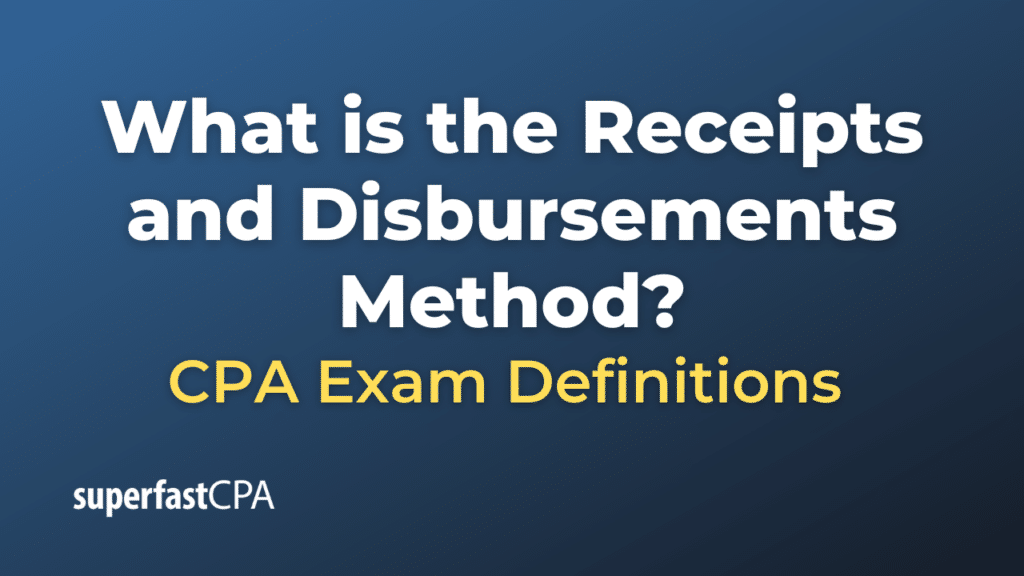Receipts and Disbursements Method
The Receipts and Disbursements Method refers to an accounting approach where revenues and expenses are recorded only when cash is received or paid, regardless of when the revenue was earned or the expense was incurred. This method is a subset of cash-basis accounting and stands in contrast to the accrual accounting method.
Key Features of the Receipts and Disbursements Method:
- Revenue Recognition: Revenues are recorded only when cash is actually received.
- Expense Recognition: Expenses are recorded only when cash is paid out.
Advantages of the Receipts and Disbursements Method:
- Simplicity: It’s straightforward and easy to understand since it tracks cash flow directly.
- Cash Flow Clarity: Provides a clear picture of how much cash a business has at any given time.
- No Receivables or Payables: Doesn’t require tracking of accounts receivable or payable, which can simplify the accounting process for very small businesses or individuals.
Limitations:
- Mismatch: Can result in a mismatch between recorded revenues and expenses in periods where revenue is earned in one period and cash is received in another.
- No Track of obligations: Doesn’t provide information on upcoming obligations (like unpaid bills) or expected cash inflows (like amounts due from customers).
- Not GAAP Compliant: This method isn’t compliant with Generally Accepted Accounting Principles (GAAP), making it unsuitable for larger corporations or public companies.
Example of Receipts and Disbursements Method:
Suppose a freelance designer performed a service for a client in December and sent an invoice for $1,000. The client paid the invoice in January.
- Under the Receipts and Disbursements Method: The revenue of $1,000 would be recorded in January when the cash was received.
- Under the Accrual Method: The revenue of $1,000 would be recorded in December when the service was rendered and the invoice sent, regardless of when payment was received.
While the Receipts and Disbursements Method can work well for very small businesses or personal finances due to its simplicity, it might not provide a complete financial picture, especially for growing businesses with more complex transactions. Most businesses, particularly larger ones, use the accrual method as it offers a more comprehensive view of financial health and performance.
Example of the Receipts and Disbursements Method
Let’s take the scenario of a small business owner, Sarah, who runs a gardening service.
Sarah’s Gardening Service
December 2022 Transactions:
- December 5: Sarah provided gardening services to a customer and billed them $500. The customer promised to pay by the end of January 2023.
- December 20: She received an invoice from her gardening supply store for tools she purchased on credit. The invoice amount was $200, with payment due by January 10, 2023.
- December 30: Sarah paid her assistant $100 for work done in December.
January 2023 Transactions:
- January 25: The customer paid Sarah the $500 they owed her for the December gardening services.
- January 8: Sarah paid the $200 invoice from the gardening supply store.
Recording Transactions using the Receipts and Disbursements Method:
December 2022:
- Revenue: $0 (Because the customer hasn’t paid yet)
- Expenses: $100 (Payment to her assistant)
- Net Income: -$100 (Revenue – Expenses)
January 2023:
- Revenue: $500 (Payment received from the customer)
- Expenses: $200 (Payment to the gardening supply store)
- Net Income: $300
Recording Transactions using the Accrual Method:
December 2022:
- Revenue: $500 (Recognized when the service was provided)
- Expenses: $300 (Including $200 for tools and $100 for assistant payment)
- Net Income: $200
January 2023:
- Revenue: $0 (No new revenue, and the December revenue was already accounted for)
- Expenses: $0 (The December expense was already accounted for)
- Net Income: $0
As you can see, the timing of revenue and expense recognition differs between the two methods. While the Receipts and Disbursements Method only recognized cash inflows and outflows, the Accrual Method recognized revenues and expenses when they were earned or incurred, regardless of the cash transaction timing.













